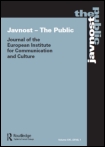Abstract
If there is no such thing as a European Public Sphere (EPS), why don’t we construct one? The answer seems to be obvious: There is no way one could construct a public sphere top-down since it depends on the active participation of speakers, the media and audience. In a democratic society they are free to deliberate with whom and about what they want. This article does not challenge the Habermasian notion of a public sphere evolving from the free discourse of the citizens. Nevertheless, the evolution of a public sphere is also structured by incentives and constraints imposed from above. The European Union structures the EPS – as a polity as well as through its policies and politics. While it is true that different policies such as media policy and all cultural policies matter for the public sphere, this paper concentrates on the Commission’s information policy as it constitutes the most direct link between the institution and the EPS. Seven different strategies of information policy will be presented which vary in their potential of creating or suppressing the evolution of a democratic public sphere. The extremes are marked by propaganda and arcane policy on the one hand and dialogue and transparency on the other hand. While the Commission pursued arcane policies for a long time, its approach to information has changed during the last decade. A change of paradigm might be under way but the legacy of European policy without “Offentlichkeit” constraints all attempts at pursuing more democratic information policies aimed at strengthening the public sphere.

Brüggemann, Michael (2005): How the EU Constructs the European Public Sphere. Seven Strategies of Information Policy. In Javnost / The Public 12 (2), pp. 57–74. Available online at https://doi.org/10.1080/13183222.2005.11008888.
